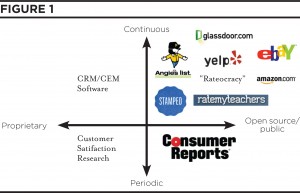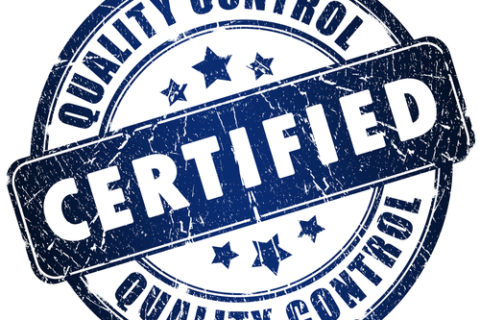Robert Moran
Ubiquitous smartphones, image-recognition algorithms, geo-location software and sensor-embedded products will create a world in which every person, place, organisation and product is rated. These ratings will be real time, transparent and available to all.
Welcome to rateocracy, a future in which every product, service provider and service location has a searchable, trackable rating. Rateocracy differs from traditional customer satisfaction research in that while customer satisfaction research is currently proprietary and periodic, research in rateocracy will be based on public and continuous rate-streams (see figure 1).
It is surprising just how close we are to this future.
We rate sellers on eBay, books on Amazon, local service providers on Angie’s List, restaurants on Yelp, vacation spots on TripAdvisor, employers on Glassdoor, movies on Rotten Tomatoes, and teachers on RateMyTeachers.com. In fact, a recent Allstate/National Journal Heartland Monitor survey of Americans (conducted by FTI Consulting, May 19-23, 2012 and based on 1,000 telephone interviews with adults by landline and cell phones) found that 54% give either a “great deal” (21%) or “some” (33%) consideration to “online reviews from other consumers on sites like Amazon, Yelp and TripAdvisor.” Millions of consumers already use the “like” button on Facebook.
Rateocracy beckons.
Evolutionary paths
But, how it develops is another story, and there are at least three paths to the era of Rrateocracy. The first is the growth of a robust, niche-by-niche ratings culture, – a simple extrapolation from where we are today. The second is the emergence of a “middleware” system that ties these disparate rating systems into one workable, searchable whole. The third is the creation of an open, universal rating platform for all people, places and things, something like those envisioned in the novels “Down and Out in the Magic Kingdom by Cory Doctorow and Super Sad True Love Story by Gary Shteyngart. Along these lines, the startup lab Milk Inc. created a universal rating app named Oink in 2011 (though this first attempt lasted only five months). A new app, Stamped, is its second attempt.
A universal rating platform must be simple and deliver the right value proposition. Paul MacDonald, product manager at Google Consumer Surveys puts it this way: “From a consumer standpoint, the challenge is in creating the right incentives to collect ratings. Personally, I’d like to consume ratings on people, places and things, but probably wouldn’t take the time to rate. Presenting me with a fast, clean interface to collect the rating and the right incentive, you might convince me to give some of my time for the greater good.”
Regardless of how rateocracy develops, it will need to navigate the twin challenges of rater appeal and data quality. These challenges are really two sides of the same coin. Greater simplicity and appeal to raters increase the number of raters and make the data more projectable. But what is gained in the simplicity of the rating scheme is lost in data granularity.
Directional data
Because open rating systems have self-selection bias, rate-streams are unlikely to become projectable data sources in the early years.
These rate-streams will, however, become increasingly useful for both refining current products and gaining robust, directional feedback on new ones. In fact, these rate-streams will be another, vital, part of the river of information which marketers must master.
Implications
Rateocracy presents at least five implications for market research.
First, rateocracy will dramatically tighten the consumer feedback loop at product launch and throughout a product’s lifecycle. Critically, rate-streams will provide real-time or near-time directional feedback at launch. This data will support the trend toward rapid product releases and iterative learning seen in both the “lean startup” movement and in “fast fashion.”
This tighter feedback loop may dramatically outpace the classic, quarterly tracking study, reducing demand for trackers and shifting that spending from interrogatory research toward data mining and analytics.
But, paradoxically, the flood of real-time information from rate-streams may actually increase ad hoc research, as trending insights require exploration via online qualitative research, proprietary customer communities (MROCs), or survey research.
A natural outgrowth of rateocracy will be the focus on elite purchase influencers, those with the strongest online reputations and the widest network reach. These super-raters will be critical to any analysis. The precursors of this can already be seen in Klout ratings today. In fact, CRM colossus Salesforce.com recently launched a service that allows businesses to monitor the Klout ratings of customers that tweet positive or negative comments about their experience. As Lee Rainie, director of the Pew Research Center’s Internet & American Life Project puts it, “In the data-rich digital world, many are known equally as much by the ratings, likes, reviews and tags they garner as they are known by their name.”
Could rateocracy turn ratings platforms into market research powerhouses? Yes. Ratings platforms of the future could follow a “freemium” model in which they give away a basic analytics suite, but charge businesses for more robust tools, advanced data mining and consulting.
Rateocracy will accelerate the existing trends in market research toward tighter feedback loops, social media listening and big data. Get ready.
Robert Moran is a partner in the Brunswick Group, and leads Brunswick’s insights function in the Americas.




3 comments
[…] Individual empowerment and extreme transparency (see the “Buycott” app and my writing on “Rateocracy” […]
[…] Rateocracy and Its Impact on Market Research – Robert Moran examines the rise of “rateocracy”, ratings of the people, by the people, for the people. Unlike conventional customer satisfaction research, which is typically proprietary, the point of ratings is the publication of those ratings to other consumers. “We rate sellers on eBay, books on Amazon, local service providers on Angie’s List, restaurants on Yelp, vacation spots on TripAdvisor, employers on Glassdoor, movies on Rotten Tomatoes, and teachers on RateMyTeachers.com… Rateocracy beckons.” Robert foresees three different ways this might evolve and discusses its impact on research. […]
[…] more here: Rateocracy and its impact on market research Related Posts:Market Research: Winter Radishes – Young & Hungry Market Research : Winter […]